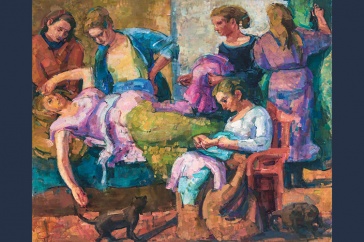
On a late winter day, Erik Wochholz '01,'07 strolls through a Victorian glasshouse at the Strawbery Banke Museum in Portsmouth. He squashes a mealybug on an African tree fern, admires a passion flower, and pinches back a leggy Velma Cox geranium. In a couple of months, some of these plants will ornament the gardens of the Goodwin Mansion. But for now, the smell of wet, hopeful earth helps him visualize the "carpet gardens" he will recreate this summer using flowering annuals, just as Sarah Goodwin, the wife of Civil War-era Governor Ichabod Goodwin, once did.
"All the Asiatic carpets she had inside her house, she attempted to mimic those in her gardens," Wochholz says. "For the Victorians it was all about family and friends and entertaining people within the landscape."
Wochholz is the historical horticulturist at Strawbery Banke, a 10-acre outdoor history museum with homes and small businesses from four centuries. He is responsible for planning and planting eight gardens, from the kitchen garden behind the 1690s Sherburne House—"It was all about food and surviving"—to the "victory garden" beside the World War II-era Marden-Abbott House and grocery store. He also develops programs to teach people how to plant and harvest heirloom seeds, and demonstrates how the early settlers used plants for food, medicine, teas and cider, perfumes, and decorations.
In the off-season, Wochholz assists with hearth cooking workshops, gives lectures, and plans the next summer's gardens. He strives to make them as historically accurate as possible, drawing on sources as diverse as interviews with elderly former residents of the museum's homes, photos, lab analysis of pollen recovered in archaeological digs, and the poetry of Thomas Bailey Aldrich, a friend and contemporary of Mark Twain whose work was inspired by his grandparents' Colonial revival garden at Aldrich House.
It's a job he largely designed for himself when the museum's curator of historic landscapes, John Forti, advertised for a new horticulturist two years ago. Wochholz had worked for five years in commercial floriculture but wanted to get away from sterile hybrids and chemical sprays.
"I wanted to get into heirlooms and the original genetics that connected our heritage and history," he says. "I was thrilled to come here."
Wochholz arrived by a winding path. While earning a B.A. in philosophy with a focus on environmental ethics, he went to New Zealand with UNH's five-week EcoQuest program. He worked on an organic farm, studied composting, and then trekked around the country for another two months. It changed his life.
"New Zealand is all about sustainability and local food," he says. "When I came back to the U.S., I knew I wanted to study and learn more about those organic practices."
He got a job on a vegetable farm in Dover and returned to UNH for a second bachelor's degree—this time, in environmental horticulture. He worked at the Woodman and Kingman research farms and interned in composting with the Sustainability Institute. People at UNH still help him: Greenhouse manager David Goudreault grows out heirloom seeds for transplant while John Hart, a professor of horticultural technology at the Thompson School, brings his students to Strawbery Banke each year to prune the fruit trees.
Now, Wochholz is focused on sharing his own knowledge. He plans to start a seed lending library this summer so local gardeners can "check out" heirloom seeds, grow them, and collect seed in the fall to return for the next year's borrowers. He trains volunteer master gardeners to work in the children's garden and teaches school groups about planting and saving seeds, composting, and garden journals. He wants to get the next generation thinking about what they eat and how it's produced.
"The closer we get to nature, the more evident it becomes that we need to preserve it, because it gives us so many things, especially our food," Wochholz says.
?
Originally published by:
UNH Magazine, Spring 2014 Issue
-
Written By:
Katharine Webster | freelance writer




















































